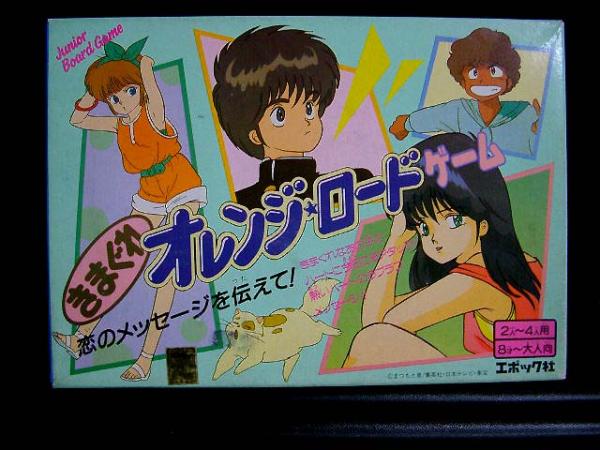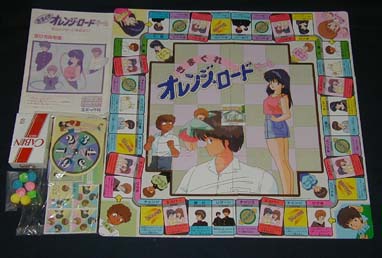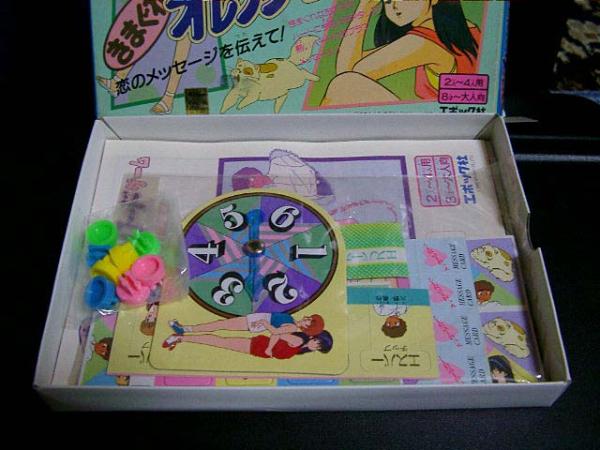
You've read the manga and novels, you've watched the series
and movies, you've listened to the radio doramas. Now play the
game! ^_^
(Note: what follows is basically a loose translation of the
instruction manual but with substantial editing and comments and
detail added in.)

For 2 to 4 players
Ages 8 to adult
By Epoch Co. Ltd, 1986-7
To mothers and fathers - to enjoy this game with your children, please read this instruction manual and teach them how to play.

1 game board (6 interlocking pieces)
42 Esper Cards
6 Coffee Time Cards
12 Message Cards
1 Esper Box
4 Esper Chips
1 roulette
4 player pieces
8 bases
(Note: the Cabin cigarette box in the pic above is not included
with the game ^_^;; It's just there for the purposes of
comparison. The game box itself is about 22cm x 16cm in size, but
since the game board comes in six parts, the area of board itself
is roughly six times the area of the game box. Note also that I
don't smoke. I have vowed that no cigarette will ever pass my
lips in my lifetime. The pic is not mine. None of the pics on
this page are mine.)

Playing the role of Ayukawa Madoka, Kasuga Kyosuke, Hiyama Hikaru or Hino Yuusaku, the players seek to borrow the esper powers of Kurumi and Manami to send their love message to the person they love. First person to do this is the winner.
(The Esper squares have Manami and Kurumi depicted on them. Since these squares are how players generally pick up Esper Cards, I guess that's why the manual refers to borrowing the esper powers of Manami and Kurumi to win the game.)
If a player stops on this square, he or she can move their Message Card piece one space and, if necessary, place an Esper Card on the board to allow their Message Card to move this one space. See below on how to move the Message Card piece and how to use Esper Cards.
If a player stops at this square and has Esper Cards, they must exchange one Esper Card with a player of their choice. When the other player has two or more cards, that other player does not have to show their cards but can let the first player guess which card to take. If the player stopping on this square has no Esper Cards, there is no effect.
If a player stops at the square of the character which he or she plays (not being a corner square), the player can take one Esper Card from one other player.
If a player stops on this square, he or she can move their player piece to the square of another player and follow the directions of that square.
About to be spotted by bad friends (ie Komatsu and Hatta)! A player stopping on this square must in future move their player piece in the opposite direction around the board (for example, counter-clockwise if they were travelling clockwise).
Miss one turn with a hangover.
As stated above, the aim of the game is to move your Message Card piece to its goal. The inner squares of the game board are blank. Message Card pieces can only move over Esper Cards - they can't move over blank squares. Thus, to win the game, the players need to collect Esper Cards, then place them over the inner squares of the board to make a path for their Message Card piece to move to the goal of intended recipient of the message. The purpose of moving the player pieces is to collect the Esper Cards which will allow the Message Card piece to be moved.
When it's a player's turn, instead of spinning the roulette and moving the player piece, the player may instead choose to move his or her Message Card piece one space and may place an Esper Card on the game board if necessary to allow the Message Card to move this one space. It's easier to explain the movement of the Message Card pieces with an example.
In the case of a person playing Kasuga Kyosuke:
Hope that all makes sense. It's a bit hard to explain without a diagram and a pic of the Esper Cards... ^_^;; Note that you can't move a Message Card piece diagonally across an Esper Card - that is, you can't move it to a space on the card opposite to the present location of the piece. The Message Card piece move to a space which shares a common edge with the space it is leaving.
Kasuka Kyosuke's Message Card piece cannot enter spaces on an
Esper Card with a pic of Hino Yuusaku or Jingoro on them.
Ayuakawa Madoka's Message Card piece cannot enter spaces on an
Esper Card with a pic of Hiyama Hikaru or Jingoro on them.
Hiyama Hikaru's Message Card piece cannot enter spaces on an
Esper Card with a pic of Ayukawa Madoka or Jingoro on them.
Hino Yuusaku's Message Card piece cannot enter spaces on an Esper
Card with a pic of Kasuga Kyosuke or Jingoro on them.
Where a player has no Esper Cards or can't place any of those cards on board to move his or her Message Card piece, then they should of course instead spin the roulette and move their player piece to collect Esper Cards.
Before a player can move his or her Message Card piece onto the goal of the character to whom the message is intended, the Message Card piece must first pass through Abcb in the centre of the game board.
Upon the Message Card piece moving to Abcb, the player must take a Coffee Time Card and follow the directions on that card. There are three types of Coffee Time Cards:
You leave Abcb by placing an Esper Card as if the Abcb did not exist. The normal rules of movement apply. I guess this means that if you enter Abcb from the square to the right of Abcb and from a space with a pic of Kyosuke on it, then to leave Abcb, you must place an Esper Card on the square to the left of Abcb and the card must have a pic of Kyosuke on it for you to move your Message Card piece onto.
It's okay to move onto Esper Cards which others have placed - the same rules apply (for example, to move onto the other Esper Card, the pics must still match up). But if you can't move onto an Esper Card which another has placed (that is, because the characters don't match up on the edge that you want to cross), you can simply place your own Esper Card on top of that card and move your Message Card piece as usual. You can place an Esper Card on top even though this may mean that the characters on other edges of the card don't match up - all that's important is that the characters on the edge which you're crossing match up. However, you can't place a new Esper Card over an old one when there is another Message Card piece on that first Esper Card.
The player who first gives their message to its intended recipient, that is, who moves their Message Card piece to the goal of the character to whom the Message Card is addressed is the winner. Remember that the Message Card piece also has to pass through Abcb first. I guess when the goal is reached, the winning player should open up their Message Card to show that they did in fact address their message to that character...
As mentioned above, four of the Message Cards are blank - one for each of the characters. Thus, if players wish to think up their own messages to send (or if they'd prefer to send a message to someone of the same sex), they can write on the blank card and play the game that way.
-----
Thank you for reading the instruction manual. If anything is unclear, please read the relevant part a second time, add your own ideas, and enjoy the "Kimagure Orange Road Game".
All rights (copyright and otherwise) reserved.